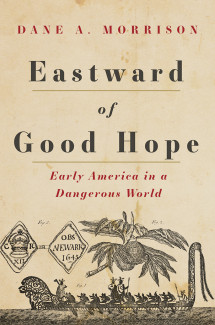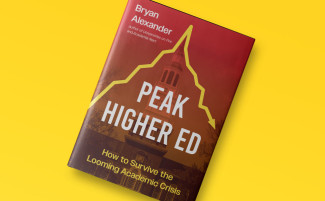
Johns Hopkins UniversityEst. 1876
America’s First Research University
Now Browsing:
Eastward of Good Hope: Early America in a Dangerous World

By Dane Morrison
In his first State of the Union address in December 1901, President Theodore Roosevelt expressed his concerns about the state of the world in words that readers would have found familiar 120 years earlier. Roosevelt drew attention particularly to dangerous events in the Philippines, an East Indies colony that the United States had acquired three years earlier in the Spanish-American War: “We are extremely anxious that the natives shall show the power of governing themselves. We are anxious, first for their sakes, and next, because it relieves us of a great burden. There need not be the slightest fear of our not continuing to give them all the liberty for which they are fit...The only fear is [lest] in our overanxiety we give them a degree of independence for which they are unfit, thereby inviting reaction and disaster.”
In his performance of benevolent regard and faux expression of “our anxiety for the welfare and progress of the Philippines,” Roosevelt echoed the voices of the Ottoman missionary Pliny Fisk, the China trader Robert Bennet Forbes, the India merchant William Augustus Rogers, and the East Indies sea captain Charles Endicott. His concerns recalled the real and imagined dangers of a world past and foreshadowed the imminent threats of a world ahead. In a discourse of colonial condescension, Roosevelt tapped into a repertoire of racial scripts to use Natalie Molina’s term, which had been employed in maritime narratives published in the period between the Treaty of Paris and the First Opium War and that had been concretized in the American consciousness. It was a language that would and amplified in American diplomacy in the modern era.
In my recent JHUP book, Eastward of Good Hope: Early America in a Dangerous World, I explore how early Americans came to define the world as a collection of dangerous sites and raise the question of where did these ideas come from? What sources of this language have remained consistent throughout two centuries of American encounters with the world? When did Americans become afraid of the world? Why did Americans come to see that reordering the lives of people who inhabited distant places “eastward of Good Hope” was their responsibility?

The answers lie in a print culture that imagined the world as hostile to American ideas, interests, lives, and livelihoods. Even before stepping onto a global stage in the 1780s, Americans had imagined the world as disordered and dangerous, deranged by tyranny or steeped in chaos, often deadly, always uncertain, unpredictable, and unstable, and their encounters after independence reinforced their assumptions. As historians assert, “seasons of misery” confronted early Americans in their “barbarous years” and particularly in distant lands among “dangerous neighbors.” This vision of the world, more than anything else, shaped Americans’ ideas of their place in the world. It has been a view shared by Puritans who carried a reformist sense of “a city upon a hill” to American shores, Yankee voyagers who freighted a mission of bringing order to a world that they found “in a constant state of flux” in the early republic and Americans today who feel inundated with news reports of acts of foreign wars, terrorism, massacres, and refugee crises.
Focusing on four representative arenas—the Ottoman Empire, China, India, and the Great South Sea (collectively, the East Indies, Oceana, and the American continent’s Northwest coast)—Eastward of Good Hope recasts the relationship between America and the world by examining the early years of the republic when its national character was particularly pliable. Its foundational posture in the world was forming. Freed from restrictions of British mercantilism, Yankee merchants sent “voyages of commerce and discovery” into distant seas. Through the “news from the East,” carried in mariners’ news reports, ships’ logs, journals, and correspondence, Americans at home imagined the world as a congeries of dangerous and incoherent sites, distinct from their own values, yet amenable to their molding.
Dane A. Morrison is a professor of early American history at Salem State University. He is the author of True Yankees: The South Seas and the Discovery of American Identity and the coeditor of Salem: Place, Myth, and Memory. His most recent book is Eastward of Good Hope: Early America in a Dangerous World.

In his first State of the Union address in December 1901, President Theodore Roosevelt expressed his concerns about the state of the world in words that readers would have found familiar 120 years earlier. Roosevelt drew attention particularly to dangerous events in the Philippines, an East Indies colony that the United States had acquired three years earlier in the Spanish-American War: “We are extremely anxious that the natives shall show the power of governing themselves. We are anxious, first for their sakes, and next, because it relieves us of a great burden. There need not be the slightest fear of our not continuing to give them all the liberty for which they are fit...The only fear is [lest] in our overanxiety we give them a degree of independence for which they are unfit, thereby inviting reaction and disaster.”
In his performance of benevolent regard and faux expression of “our anxiety for the welfare and progress of the Philippines,” Roosevelt echoed the voices of the Ottoman missionary Pliny Fisk, the China trader Robert Bennet Forbes, the India merchant William Augustus Rogers, and the East Indies sea captain Charles Endicott. His concerns recalled the real and imagined dangers of a world past and foreshadowed the imminent threats of a world ahead. In a discourse of colonial condescension, Roosevelt tapped into a repertoire of racial scripts to use Natalie Molina’s term, which had been employed in maritime narratives published in the period between the Treaty of Paris and the First Opium War and that had been concretized in the American consciousness. It was a language that would and amplified in American diplomacy in the modern era.
In my recent JHUP book, Eastward of Good Hope: Early America in a Dangerous World, I explore how early Americans came to define the world as a collection of dangerous sites and raise the question of where did these ideas come from? What sources of this language have remained consistent throughout two centuries of American encounters with the world? When did Americans become afraid of the world? Why did Americans come to see that reordering the lives of people who inhabited distant places “eastward of Good Hope” was their responsibility?

The answers lie in a print culture that imagined the world as hostile to American ideas, interests, lives, and livelihoods. Even before stepping onto a global stage in the 1780s, Americans had imagined the world as disordered and dangerous, deranged by tyranny or steeped in chaos, often deadly, always uncertain, unpredictable, and unstable, and their encounters after independence reinforced their assumptions. As historians assert, “seasons of misery” confronted early Americans in their “barbarous years” and particularly in distant lands among “dangerous neighbors.” This vision of the world, more than anything else, shaped Americans’ ideas of their place in the world. It has been a view shared by Puritans who carried a reformist sense of “a city upon a hill” to American shores, Yankee voyagers who freighted a mission of bringing order to a world that they found “in a constant state of flux” in the early republic and Americans today who feel inundated with news reports of acts of foreign wars, terrorism, massacres, and refugee crises.
Focusing on four representative arenas—the Ottoman Empire, China, India, and the Great South Sea (collectively, the East Indies, Oceana, and the American continent’s Northwest coast)—Eastward of Good Hope recasts the relationship between America and the world by examining the early years of the republic when its national character was particularly pliable. Its foundational posture in the world was forming. Freed from restrictions of British mercantilism, Yankee merchants sent “voyages of commerce and discovery” into distant seas. Through the “news from the East,” carried in mariners’ news reports, ships’ logs, journals, and correspondence, Americans at home imagined the world as a congeries of dangerous and incoherent sites, distinct from their own values, yet amenable to their molding.
Dane A. Morrison is a professor of early American history at Salem State University. He is the author of True Yankees: The South Seas and the Discovery of American Identity and the coeditor of Salem: Place, Myth, and Memory. His most recent book is Eastward of Good Hope: Early America in a Dangerous World.

Login to View & Leave Comments
Login to View & Leave Comments


